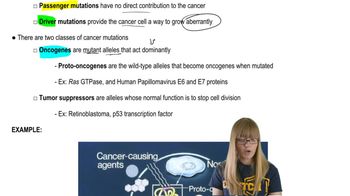Table of contents
- 1. Introduction to Genetics51m
- 2. Mendel's Laws of Inheritance3h 37m
- 3. Extensions to Mendelian Inheritance2h 41m
- 4. Genetic Mapping and Linkage2h 28m
- 5. Genetics of Bacteria and Viruses1h 21m
- 6. Chromosomal Variation1h 48m
- 7. DNA and Chromosome Structure56m
- 8. DNA Replication1h 10m
- 9. Mitosis and Meiosis1h 34m
- 10. Transcription1h 0m
- 11. Translation58m
- 12. Gene Regulation in Prokaryotes1h 19m
- 13. Gene Regulation in Eukaryotes44m
- 14. Genetic Control of Development44m
- 15. Genomes and Genomics1h 50m
- 16. Transposable Elements47m
- 17. Mutation, Repair, and Recombination1h 6m
- 18. Molecular Genetic Tools19m
- 19. Cancer Genetics29m
- 20. Quantitative Genetics1h 26m
- 21. Population Genetics50m
- 22. Evolutionary Genetics29m
19. Cancer Genetics
Cancer Mutations
Problem 27b
Textbook Question
Those who inherit a mutant allele of the RB1 tumor-suppressor gene are at risk for developing a bone cancer called osteosarcoma. You suspect that in these cases, osteosarcoma requires a mutation in the second RB1 allele, and you have cultured some osteosarcoma cells and obtained a cDNA clone of a normal human RB1 gene. A colleague sends you a research paper revealing that a strain of cancer-prone mice develop malignant tumors when injected with osteosarcoma cells, and you obtain these mice. Using these three resources, what experiments would you perform to determine (a) whether osteosarcoma cells carry two RB1 mutations, (b) whether osteosarcoma cells produce any pRB protein, and (c) if the addition of a normal RB1 gene will change the cancer-causing potential of osteosarcoma cells?
 Verified step by step guidance
Verified step by step guidance1
Design an experiment to sequence the RB1 gene from the osteosarcoma cells to identify mutations in both alleles. Use PCR to amplify the RB1 gene, followed by sequencing to compare with the normal RB1 sequence.
Perform a Western blot analysis to detect the presence of pRB protein in osteosarcoma cells. Extract proteins from the cells, run them on an SDS-PAGE gel, and use an antibody specific to pRB to determine if the protein is expressed.
Introduce the normal RB1 cDNA clone into osteosarcoma cells using a suitable vector for gene expression. Use a control group of osteosarcoma cells without the RB1 cDNA for comparison.
Inject both the modified osteosarcoma cells (with normal RB1) and the control cells into the cancer-prone mice. Monitor the development of tumors in both groups of mice over time.
Analyze the tumor development results to determine if the introduction of the normal RB1 gene reduces the cancer-causing potential of the osteosarcoma cells compared to the control group.
Recommended similar problem, with video answer:
 Verified Solution
Verified SolutionThis video solution was recommended by our tutors as helpful for the problem above
Video duration:
1mPlay a video:
Was this helpful?
Key Concepts
Here are the essential concepts you must grasp in order to answer the question correctly.
RB1 Tumor-Suppressor Gene
The RB1 gene encodes the retinoblastoma protein (pRB), which is crucial for regulating the cell cycle and preventing uncontrolled cell growth. Mutations in this gene can lead to the loss of its tumor-suppressing function, increasing the risk of cancers such as osteosarcoma. Understanding the role of RB1 in cell cycle regulation is essential for analyzing how mutations contribute to tumorigenesis.
Recommended video:
Guided course

Mapping Genes
cDNA and Gene Expression Analysis
cDNA (complementary DNA) is synthesized from mRNA and is used to study gene expression. By comparing the cDNA of osteosarcoma cells to that of normal cells, researchers can determine whether the RB1 gene is expressed and if the pRB protein is produced. This analysis is vital for assessing the functional status of the RB1 gene in cancer cells.
Recommended video:
Guided course

Penetrance and Expressivity
Experimental Models in Cancer Research
Using animal models, such as cancer-prone mice, allows researchers to study the effects of specific genetic mutations on tumor development. By injecting these mice with osteosarcoma cells, one can observe the tumorigenic potential and the impact of introducing a normal RB1 gene. This approach helps elucidate the mechanisms of cancer progression and the potential for gene therapy.
Recommended video:
Guided course

Cancer Characteristics

 4:50m
4:50mWatch next
Master Cancer Mutations with a bite sized video explanation from Kylia Goodner
Start learningRelated Videos
Related Practice


